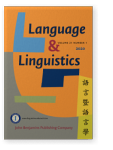Vol. 21:1 (2020) ► pp.104–144
Mandarin Chinese buguo (‘but’) as a metacoherence marker in TV/radio interview talks
This study examines the uses of Mandarin Chinese buguo ‘but’ as a contrastive discourse marker (CM) in spoken discourse. The data were taken from casual conversations, TV/radio single-interviewee interviews and TV panel news interviews. We found that two main types of the CM buguo were used to mark contrast: restrictive buguo and cancellative buguo. Restrictive buguo is similar to the adv buguo in usage in that it modifies the validity of the preceding proposition to signal implicit contrast. Cancellative buguo is used to cancel the validity of a previous proposition to indicate explicit contrast. As such, restrictive buguo can serve as a topic-shift marker and to convey implicit disagreement; cancellative buguo often acts as a topic-change marker used to introduce explicit disagreement. In particular, both restrictive buguo and cancellative buguo can serve as metacoherence markers, which are often employed by interview hosts/hostesses to make the discourse optimally coherent.
Article outline
- 1.Introduction
- 1.1Types of buguo
- 1.2Previous studies on buguo
- 2.Data and method
- 3.Distribution and occurrence of buguo in the data
- 4.The discourse-pragmatic functions of buguo
- 4.1Marking contrast
- 4.1.1Restrictive adv buguo
- 4.1.2Restrictive CM buguo
- 4.1.3Cancellative CM buguo
- 4.1.4Marking contrast in a continuum
- 4.2Marking transition within a speaker’s turn
- 4.3Marking transition across speaker turns
- 4.4Displaying disagreement
- 4.1Marking contrast
- 5. Buguo as a metacoherence marker
- 6.The uses of buguo in the single-interviewee interview data and in the panel discussion data
- 7.Conclusion
- Acknowledgements
- Notes
- Abbreviations
-
References
For any use beyond this license, please contact the publisher at [email protected].
